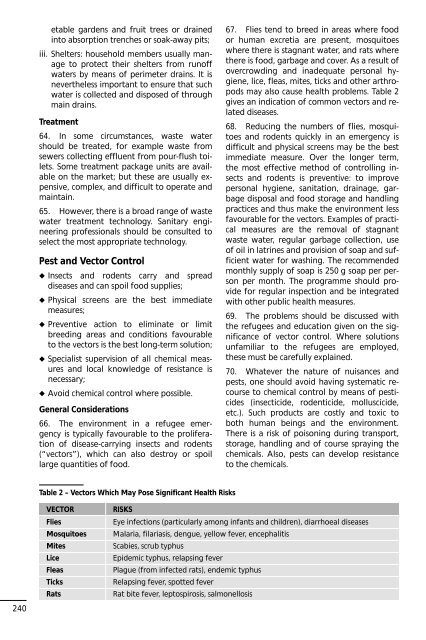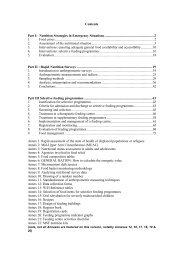UNHCR Handbook for Emergencies - UNHCR eCentre
UNHCR Handbook for Emergencies - UNHCR eCentre
UNHCR Handbook for Emergencies - UNHCR eCentre
You also want an ePaper? Increase the reach of your titles
YUMPU automatically turns print PDFs into web optimized ePapers that Google loves.
240<br />
etable gardens and fruit trees or drained<br />
into absorption trenches or soak-away pits;<br />
iii. Shelters: household members usually manage<br />
to protect their shelters from runoff<br />
waters by means of perimeter drains. It is<br />
nevertheless important to ensure that such<br />
water is collected and disposed of through<br />
main drains.<br />
Treatment<br />
64. In some circumstances, waste water<br />
should be treated, <strong>for</strong> example waste from<br />
sewers collecting effluent from pour-flush toilets.<br />
Some treatment package units are available<br />
on the market; but these are usually expensive,<br />
complex, and difficult to operate and<br />
maintain.<br />
65. However, there is a broad range of waste<br />
water treatment technology. Sanitary engineering<br />
professionals should be consulted to<br />
select the most appropriate technology.<br />
Pest and Vector Control<br />
◆ Insects and rodents carry and spread<br />
diseases and can spoil food supplies;<br />
◆ Physical screens are the best immediate<br />
measures;<br />
◆ Preventive action to eliminate or limit<br />
breeding areas and conditions favourable<br />
to the vectors is the best long-term solution;<br />
◆ Specialist supervision of all chemical measures<br />
and local knowledge of resistance is<br />
necessary;<br />
◆ Avoid chemical control where possible.<br />
General Considerations<br />
66. The environment in a refugee emergency<br />
is typically favourable to the proliferation<br />
of disease-carrying insects and rodents<br />
(“vectors”), which can also destroy or spoil<br />
large quantities of food.<br />
Table 2 – Vectors Which May Pose Significant Health Risks<br />
67. Flies tend to breed in areas where food<br />
or human excretia are present, mosquitoes<br />
where there is stagnant water, and rats where<br />
there is food, garbage and cover. As a result of<br />
overcrowding and inadequate personal hygiene,<br />
lice, fleas, mites, ticks and other arthropods<br />
may also cause health problems. Table 2<br />
gives an indication of common vectors and related<br />
diseases.<br />
68. Reducing the numbers of flies, mosquitoes<br />
and rodents quickly in an emergency is<br />
difficult and physical screens may be the best<br />
immediate measure. Over the longer term,<br />
the most effective method of controlling insects<br />
and rodents is preventive: to improve<br />
personal hygiene, sanitation, drainage, garbage<br />
disposal and food storage and handling<br />
practices and thus make the environment less<br />
favourable <strong>for</strong> the vectors. Examples of practical<br />
measures are the removal of stagnant<br />
waste water, regular garbage collection, use<br />
of oil in latrines and provision of soap and sufficient<br />
water <strong>for</strong> washing. The recommended<br />
monthly supply of soap is 250 g soap per person<br />
per month. The programme should provide<br />
<strong>for</strong> regular inspection and be integrated<br />
with other public health measures.<br />
69. The problems should be discussed with<br />
the refugees and education given on the significance<br />
of vector control. Where solutions<br />
unfamiliar to the refugees are employed,<br />
these must be carefully explained.<br />
70. Whatever the nature of nuisances and<br />
pests, one should avoid having systematic recourse<br />
to chemical control by means of pesticides<br />
(insecticide, rodenticide, molluscicide,<br />
etc.). Such products are costly and toxic to<br />
both human beings and the environment.<br />
There is a risk of poisoning during transport,<br />
storage, handling and of course spraying the<br />
chemicals. Also, pests can develop resistance<br />
to the chemicals.<br />
VECTOR RISKS<br />
Flies Eye infections (particularly among infants and children), diarrhoeal diseases<br />
Mosquitoes Malaria, filariasis, dengue, yellow fever, encephalitis<br />
Mites Scabies, scrub typhus<br />
Lice Epidemic typhus, relapsing fever<br />
Fleas Plague (from infected rats), endemic typhus<br />
Ticks Relapsing fever, spotted fever<br />
Rats Rat bite fever, leptospirosis, salmonellosis



